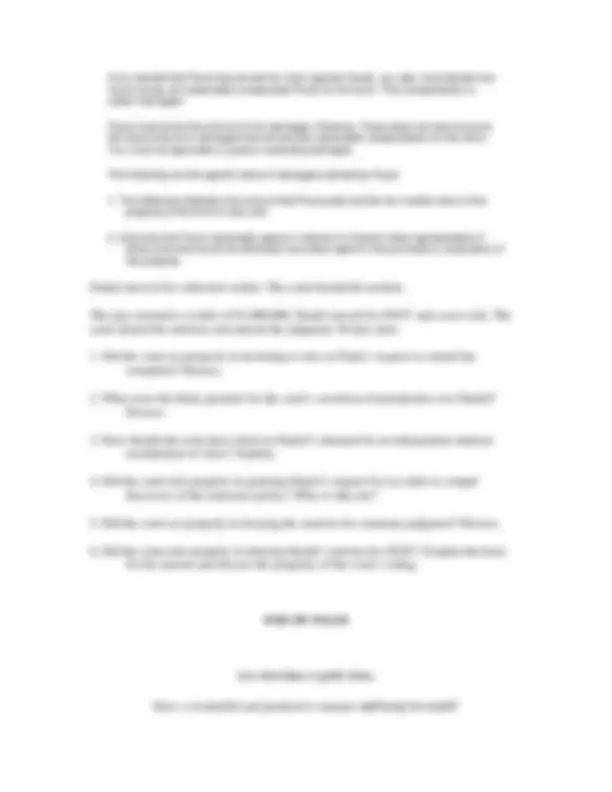



Study with the several resources on Docsity

Earn points by helping other students or get them with a premium plan


Prepare for your exams
Study with the several resources on Docsity

Earn points to download
Earn points by helping other students or get them with a premium plan
Community
Ask the community for help and clear up your study doubts
Discover the best universities in your country according to Docsity users
Free resources
Download our free guides on studying techniques, anxiety management strategies, and thesis advice from Docsity tutors
This is the Past Exam of Civil Procedure and its key important points are: Request to Amend Complaint, Professional Appraiser, Reasonable Compensation, Items of Damages Claimed, Acquisition of Property, Independent Medical Examination, Discovery of Insurance Policy
Typology: Exams
1 / 3

This page cannot be seen from the preview
Don't miss anything!


Professor Lois Schwartz
SPRING 2008
Part I consists of twenty-five (25) multiple-choice questions. Correct multiple choice answers are to be marked on the separate “ParSCORE TEST FORM” using pen or pencil and following the instructions on that form. If you change your answer, place a clear “X” through the wrong answer and mark the correct answer. A machine will score the exam and any ambiguities will be counted as a wrong answer.
Part II consists of one (1) essay question. Please write your response in the blue books provided. Please write clearly. Write on every other line and every other page to permit instructor comments.
GOOD LUCK!
Part II: Essay Question
Paula, a citizen of California, purchased a painting from Daniel, a citizen of New York. The transaction took place in Los Angeles, and Paula paid Daniel $100,000. Daniel delivered the painting. Paula then hired Alice, a professional appraiser, to assess the painting. Alice concluded that it was worth $500. Paula paid Alice $650 for her services. Paula then sued Daniel in Los Angeles Superior Court for damages.
After Paula filed the original complaint, but before Daniel had responded, she grew suspicious about other works of art that she had purchased from Daniel. Alice conducted further appraisals, and found that two sculptures Paula had purchased from Daniel for $50,000 were each worthless. She also found out that Daniel maintained an underground blog in which he boasted of his exploits and identified Paula as one of his “easiest victims.”
Paula requested the court to grant leave to amend her complaint to add causes of action for the sculpture and Daniel’s defamatory remarks. The court declined to rule on her request.
Daniel filed an answer to the original complaint, denying Paula’s allegations of fraud and breach of contract, and also alleging as an affirmative defense that the court lacked jurisdiction over the case. The court ruled that it had jurisdiction over Daniel on multiple grounds and allowed the original complaint to proceed.
Paula and Daniel conducted discovery. Daniel discovered that Paula’s appraiser had had eye surgery immediately prior to appraising Paula’s works of art and was legally blind. In order to impeach Alice’s testimony, he wanted to have his own doctor check Alice’s eyesight, so he served Alice with a Notice to Appear before a Licensed Ophthalmologist to be Chosen by Daniel. Paula objected.
Daniel also discovered that Paula maintained a current insurance policy on her art collection. He demanded that Paula produce the policy. She declined, stating that it was not relevant to the litigation. Daniel requested that the court grant an order to compel discovery. Over Paula’s opposition, the court granted Daniel’s motion.
After discovery concluded, Daniel moved for summary judgment, basing his statement of undisputed facts on the information in the insurance policy. He stapled a copy of the insurance policy to his motion. Paula also filed a motion for summary judgment, basing her statement of undisputed facts on Alice’s assessment, and attaching a photocopy of the appraisal. Each party filed an opposition to the other’s motion. The court denied both motions.
The case proceeded to trial. At trial, and over objections from both Paula and Daniel, the judge provided the jury with a version of CACI Rule 1920 stating that: